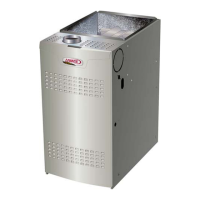Page 51
V-TYPICAL OPERATING CHARACTERISTICS
A-Blower Operation and Adjustment
1 - Blower operation is dependent on thermostat control
system.
2 - Generally, blower operation is set at thermostat sub-
base fan switch. With fan switch in ON position, blower
operates continuously. With fan switch in AUTO posi-
tion, blower cycles with demand or runs continuously
while heating or cooling circuit cycles.
3 - Depending on the type of indoor thermostat, blower
and entire unit will be o when the system switch is in
OFF position.
B-Temperature Rise (FIGURE 22)
Temperature rise for SL280UHV units depends on unit in-
put, blower speed, blower horsepower and static pressure
as marked on the unit rating plate. The blower speed must
be set for unit operation within the range of “TEMP. RISE
°F” listed on the unit rating plate.
Supply Air
Return Air
TEMPERATURE RISE
Supply Duct Temperature ________
Return Duct Temperature
_
_____
Temperature Rise = ________
FIGURE 22
C-External Static Pressure
1 - Tap locations shown in FIGURE 23.
2 - Punch a 1/4” diameter hole in supply and return air ple-
nums. Insert manometer hose ush with inside edge
of hole or insulation. Seal around the hose with per-
magum. Connect the zero end of the manometer to
the discharge (supply) side of the system. On ducted
systems, connect the other end of manometer to the
return duct as above.
3 - With only the blower motor running and the evaporator
coil dry, observe the manometer reading. Adjust blow-
er motor speed to deliver the air desired according to
the job requirements. For heating speed external static
pressure drop must not be more than 0.5” W.C. For
cooling speed external static pressure drop must not
be more than 0.8” W.C.
4 - Seal the hole when the check is complete.
EXTERNAL STATIC PRESSURE
Supply Duct Static ________
Return Duct Static + _____
Total Duct Static =
________
(dry coil)
Supply Air
Return Air
or
FIGURE 23

